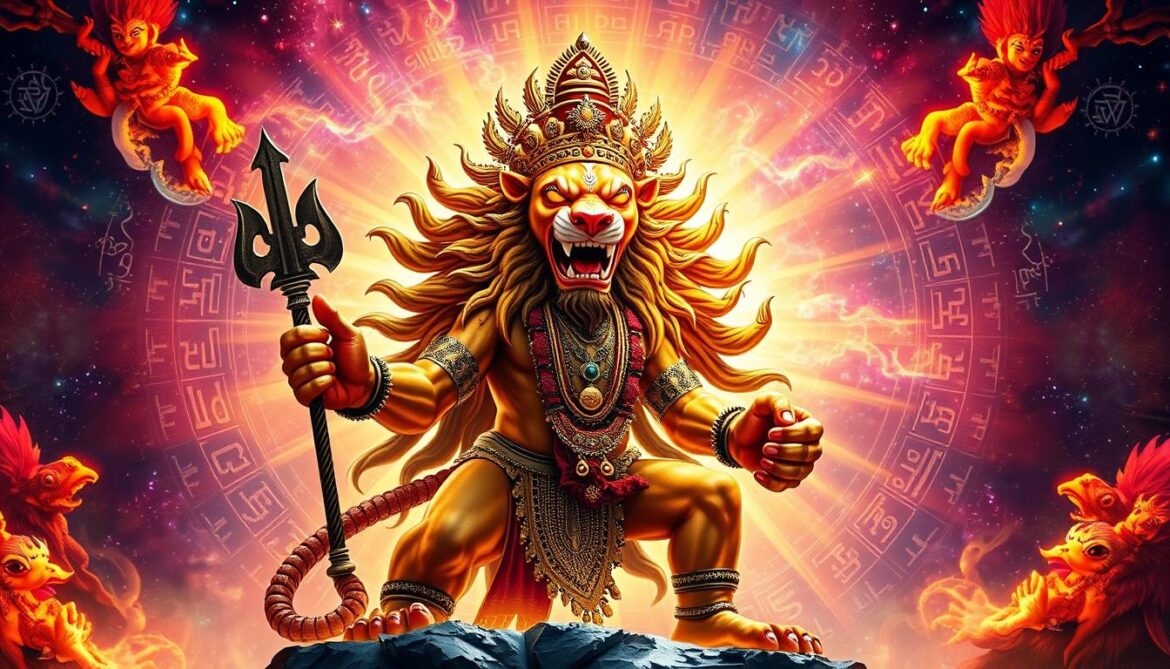Life can be tough, with challenges that seem too big to handle. In these hard times, stories of divine power can offer comfort. The story of Lord Narasimha is a powerful reminder of strength and protection.
This unique Narasimha avatar combines human and lion, showing us the divine power we seek. It’s a symbol of hope and courage in times of fear and despair.
Narasimha is a key figure in Hindu mythology, known for protecting and offering hope. The Narasimha Purana tells us about this amazing form of Lord Vishnu. It teaches us about the balance between good and evil.
By learning from these stories, we understand the value of devotion. It gives us the courage to face even the darkest challenges.
The Significance of Lord Narasimha in Hindu Mythology
Lord Narasimha is very important in Hindu mythology. He is the fourth avatar of Vishnu. Narasimha stands for protection and justice, fighting against evil.
He is loved in many traditions, like Vaikhanasas and Sri Vaishnavism. His stories show the balance between power and kindness. For example, his half-lion, half-man form shows his strength against evil.
Art from the 4th century CE shows Narasimha. This shows that worship of Vishnu avatars is very old. These stories remind us of faith, courage, and protection.
The story of Narasimha is more than just a tale. It is a big part of many people’s beliefs. His legacy inspires devotion and shows the power of faith.
Understanding the Story of Narasimha and Hiranyakashipu
The Narasimha story is a deep tale of good vs. evil. Hiranyakashipu, a demon king, got a special boon from Lord Brahma. This made him almost unbeatable.
He wanted to rule all three worlds: Heaven, Earth, and Patala. His pride turned him into a cruel ruler. He made everyone worship only him.
Hiranyakashipu was born because of a curse. It was placed by the Four Kumaras on Jaya and Vijaya. He and his brother, Hiranyaksha, were born to Diti and sage Kashyapa in the Satya Yuga.
His son, Prahlada, loved Lord Vishnu very much. Hiranyakashipu tried to kill him many times. But, divine help always saved Prahlada.
Narasimha, Vishnu’s half-lion half-man form, came to save the day. He fought Hiranyakashipu and won. Narasimha was so fierce that even gods couldn’t calm him down.
Prahlada’s devotion finally brought peace. He asked for a special gift from Narasimha. He wanted to never have selfish desires again.
Narasimha gave Prahlada a kingdom on Earth for a long time. This showed the importance of giving up worldly desires. The Narasimha story teaches us about devotion and the need for divine help.
Devotion Personified: The Tale of Prahlada
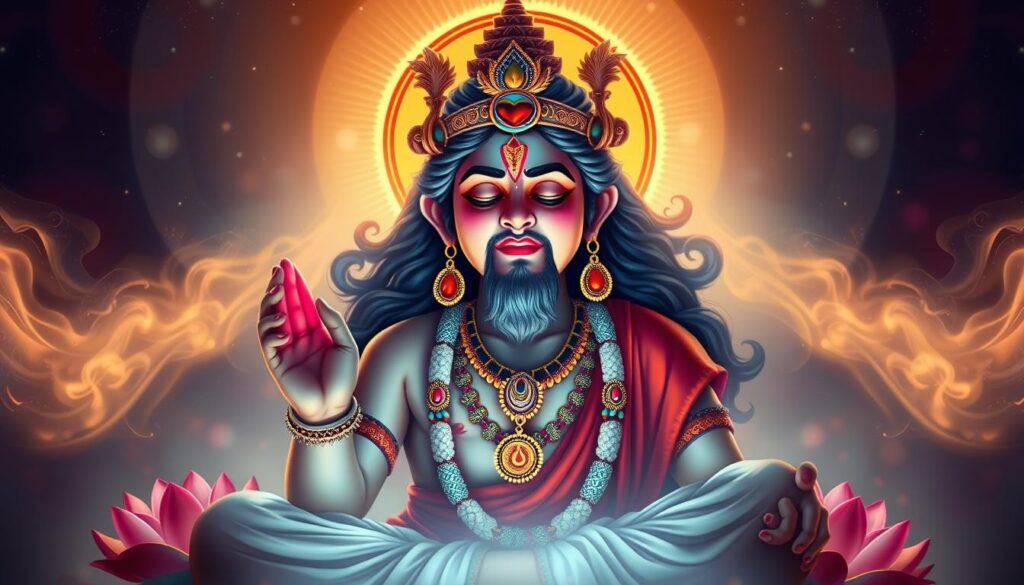
In Hindu mythology, Bhakta Prahlada’s story is a shining example of faith and strength. As a young boy, he showed deep devotion to Vishnu, unlike his father Hiranyakashipu. His faith never faltered, even when his life was threatened.
Prahlada learned about Krishna Consciousness in his mother’s womb. Narada Muni taught him during a time of war between gods and demons. This early learning made his devotion to Vishnu even stronger as he grew up.
At just five, Prahlada taught his friends about Vishnu. He stood up to his father’s harsh beliefs, showing true devotion. His father wanted power, but Prahlada focused on spirituality, showing the difference between worldly goals and divine love.
Hiranyakashipu tried hard to change Prahlada’s mind, but the young prince never gave up. Even when he was tortured, Prahlada survived, thanks to Vishnu’s protection. His story teaches us that good always wins and that staying strong is key.
Prahlada’s devotion led to the arrival of Narasimha, Vishnu’s fierce form. Narasimha saved Prahlada and showed divine justice. After Hiranyakashipu’s death, Prahlada’s rule brought a positive change to the asuras, showing the power of good living.
The Ugra Narasimha Form and Its Implications

The Ugra Narasimha form is a mix of divine anger and strong protection. He has sixteen hands, each with a weapon. This shows his strong will to fight for justice and get rid of evil.
In Hindu texts, Ugra Narasimha is a key figure. He shows the need to face darkness with divine power.
Ugra Narasimha’s impact goes beyond just symbols. He reminds us that justice can be fierce against chaos and ignorance. His image calls on followers to stand up against evil.
Temples like the one in Ahobilam, Andhra Pradesh, highlight his importance. Many people visit to find peace and protection from this divine warrior. In Odisha, his fierce form is seen differently, showing his role as a protector.
Festivals like Ugadi in South India celebrate Ugra Narasimha. These events honor his legacy and connect him to life’s cycles in Hindu traditions.
Ugra Narasimha is also part of Tantric traditions. He is seen as a powerful deity helping people win inner battles. His many forms, over 74, show his complex nature. Forms like Lakshmi Narasimha highlight his connection to fortune.
In short, Ugra Narasimha represents balance between divine anger and justice. He guides followers seeking strength and protection. Worship includes special mantras to honor his fierce nature.
Lord Narasimha’s Divine Protection and Justice

Lord Narasimha’s story shows us divine protection and justice in Hindu myths. His form stands for defending the right against wrong. Prahlada’s faith in Lord Narasimha shows the power of staying true to what is right.
The Concept of Divine Protection
People believe divine protection is for all who stay faithful. Lord Narasimha’s role assures us we are safe on our spiritual journey. He gives us strength to face hard times.
Chanting the Narasimha Mantra, with 12 key phrases, shows his protective power. People often chant 108 times, showing their full commitment to the divine.
Cosmic Balance Restored: The Role of Lord Narasimha
As Lord Vishnu’s fourth form, Lord Narasimha is key to keeping the universe balanced. His fight against evil, like in the story of Prahlada and Hiranyakashipu, shows divine power over evil. His Jayanti day is filled with fasting and special prayers, showing our unity in seeking protection and peace.
| Aspect | Description |
|---|---|
| Mantra Composition | Composed of 12 Sanskrit phrases with profound significance. |
| Chanting Practice | 108 repetitions are recommended, symbolizing wholeness. |
| Spiritual Themes | Focus on divine justice, compassion, and overcoming fears. |
| Celebration Date | Narasimha Jayanti occurs on the 14th day of the bright half of the Vaishakha month. |
| Rituals and Fasting | Includes Nirjala, Phalahar, and Satvik fasting methods. |
Lord Narasimha’s story teaches us about divine protection and justice. It shows the victory of good over evil and the freedom that worship brings.
Narasimha Jayanti: Celebrating the Divine Avatar
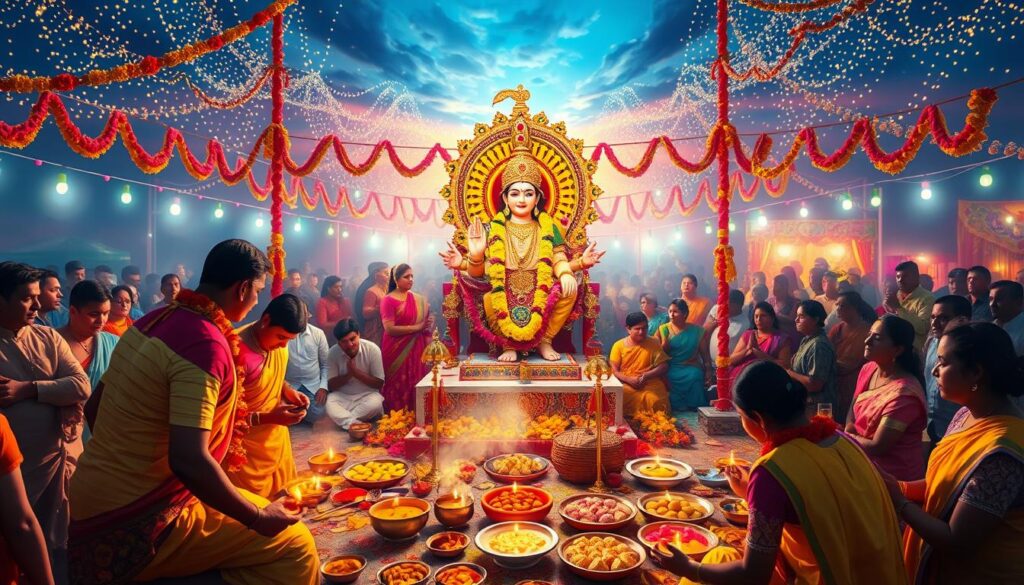
Narasimha Jayanti is a big event in the Hindu calendar. It happens on the 14th day of Shukla Paksha in Vaishakha, usually in May. This day celebrates Lord Narasimha, the fourth form of Lord Vishnu, who stands for protection and victory over evil.
The cultural significance of Narasimha Jayanti goes beyond just worship. It brings people together through shared rituals and celebrations.
On Narasimha Jayanti, people take holy dips in sacred rivers. They offer pujas with items like coconut and sandalwood. They also recite powerful mantras and perform aarti.
Many devotees fast completely, like on Ekadashi. They eat only one meal and avoid grains. This shows their respect and wish for blessings to overcome challenges.
The story of Lord Narasimha is tied to Prahlada and Hiranyakashipu. It teaches about staying strong and faithful. In India, especially in Telangana and Andhra Pradesh, people celebrate with chanting and prayers for strength and protection.
| Celebration Date | Significant Activities | Common Offerings | Temples of Note |
|---|---|---|---|
| May 21, 2024 | Puja, Aarti, and Fasting | Coconut, Sandalwood, Peacock Feathers | Narasimha Swamy Temple, Ahobilam |
| May 11, 2025 | Ritual Bath, Chanting | Maize Flour, Cold Water | Lakshmi Narasimha Temple, Bhadrak |
The devotional practices on Narasimha Jayanti show faith in Lord Narasimha’s power. This special day reminds us of hope and strength. It brings people together in faith and community spirit.
Narasimha Mantra and Its Spiritual Significance
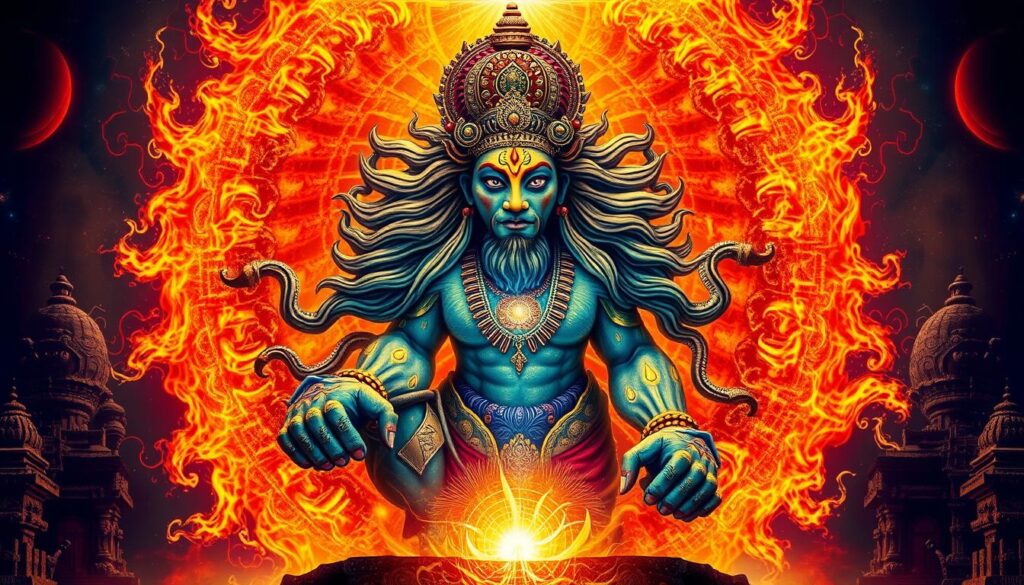
The Narasimha mantra is very important for those who follow it. It asks for strength and protection. It’s not just words; it’s a way to honor Lord Narasimha, a form of Lord Vishnu.
People think that saying this mantra gives them courage. It helps them face hard times in life.
Chanting for Protection and Strength
Chanting the Narasimha mantra keeps bad energies away. It’s a protection mantra. A famous one is “Ugram Veeram Maha Vishnum Jvalantam Sarvato Mukham Nrusimham Bheeshanam Bhadram Mrutyur Mrutyum Namahyaham”.
It’s best to say it early in the morning. This sends good vibes around you.
Doing this for 21 to 40 days can make you braver and more confident. You’ll feel less scared. You might face north, wear yellow, and light a ghee lamp and incense.
Connection to Devotional Practices
The Narasimha mantra is key in Hindu devotions. It shows the value of following spiritual rules. It helps people connect with the divine.
Many chant these devotional chants to feel closer to Lord Narasimha. They want to be free from worries and get what they wish for.
Thinking about Lord Narasimha’s kindness and strength helps. Chanting and devotion bring spiritual protection and better health.
| Narasimha Mantra | Spiritual Benefits | Chanting Duration | Recommended Time |
|---|---|---|---|
| Ugram Veeram Maha Vishnum | Courage, Confidence, Fearlessness | 21 to 40 Days | 4 am to 6 am |
| Sri Narasimha Maha Mantra | Protection from evil, Alleviation of troubles | Ongoing Practice | During Brahma Muhurat |
| Narasimha Gayatri Mantra | Positive vibrations, Spiritual liberation | As desired | Morning hours |
Temples Dedicated to Lord Narasimha Across India
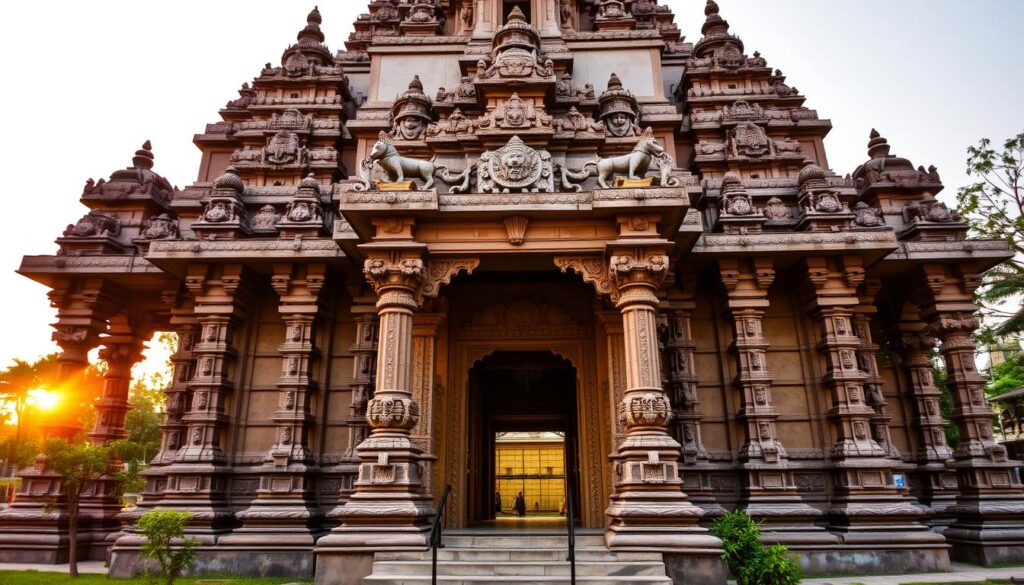
Lord Narasimha is very important in Hindu worship. There are over 1000 Narasimha temples in India. Each temple shows a special part of spirituality and the cultural value of this deity.
Ahobilam in Andhra Pradesh has nine temples for Lord Narasimha, called the Nava Narasimha Kshetram. This place shows deep devotion to this avatar. It draws pilgrims seeking blessings and healing.
The Yadagirigutta Narasimha Temple in Telangana is part of the Pancha Narasimha Kshetram. It offers many ways to worship. There are 25 important Narasimha Kshetrams in India. This shows the variety and deep religious meaning of these sites.
Here’s a list of some famous Narasimha temples:
| Temple Name | Location | Notable Features |
|---|---|---|
| Ahobilam | Andhra Pradesh | Nine temples dedicated to Lord Narasimha |
| Sri Malyadri Lakshmi Narasimha Swami Devastanam | Andhra Pradesh | Part of Nava Narasimhas |
| Yadagirigutta Narasimha Temple | Telangana | Multiple forms of Narasimha worship |
| Mangalagiri Narasimhar Temple | Andhra Pradesh | Famous for jaggery water Prasadam |
| Simhachalam Narasimha Temple | Andhra Pradesh | Requires climbing over 350 steps |
| Melkote Narasimha Temple | Karnataka | Established by Ramanuja, over 1000 years old |
| Narasimha Temple | Mysore | Idol made of Salagrama stone |
| Narasimha Temple | Thirukovilur | Visited by the first three Alwars |
| Narasimha Temple | Sholingur | Mountain temple requiring over 1000 steps |
| Narasimha Temple | Poovarasankuppam, Tamil Nadu | Known as Booloka Vaikuntam |
These temples are important sacred sites. They offer chances for spiritual journeys. Visiting these places lets devotees worship, take part in rituals, and feel Lord Narasimha’s presence.
Iconography: The Half-Lion Half-Man Avatar
![]()
The Narasimha iconography shows Lord Narasimha as a half-lion half-man figure. This image captures his fierce and compassionate sides. It shows the divine’s dual nature. Worship rituals focus on protection and justice, teaching strength and humility.
Symbolism in Worship and Rituals
Lord Narasimha’s symbolism is key in Hindu rituals. Devotees call on this form for protection and guidance. They offer prayers and chant to connect with Narasimha’s divine energy.
Rituals are personal, making each one special. They help people feel closer to their faith.
Artistic Representations in Sculptures and Paintings
Lord Narasimha is depicted in many Indian temples and art. Sculptures and paintings show his battles and calm moments. They highlight his strength and kindness.
Artistic styles vary, showing different sides of Narasimha. His story is a reminder of his symbolic themes.
The Influence of Narasimha on the Bhakti Movement
Narasimha’s influence deeply shaped the Bhakti movement. It focused on personal devotion and heartfelt worship. From the 7th to the 12th centuries, poet saints like the Alvars and Nayanars shared their spiritual journeys.
They were inspired by figures like Prahlada. Their teachings created a rich tapestry of devotional literature in many Indian languages.
In the 12th century, Ramananda’s works expanded the movement. This led to literary growth in Hindi, Marathi, Gujarati, Bengali, and Punjabi. Poets like Kabir and Mirabai wrote powerful works.
They wrote about Lord Krishna, showing the spiritual inspiration in their words. Their writings set a foundation for future generations. They let Narasimha’s influence live on in their writings.
Narasimha’s impact on the Bhakti movement went beyond literature. It brought equality and harmony between Hindus and Muslims. This created a space where spirituality was shared by all, beyond caste.
Today, Narasimha’s stories and teachings still inspire devotion. They remind us of the importance of spiritual connection and personal worship.

